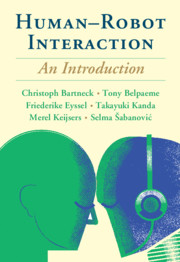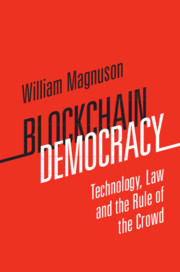Refine search
Actions for selected content:
2860 results in Computing and Society
6 - Nonverbal Interaction
-
- Book:
- Human-Robot Interaction
- Published online:
- 20 February 2020
- Print publication:
- 07 May 2020, pp 81-97
-
- Chapter
- Export citation
4 - Design
-
- Book:
- Human-Robot Interaction
- Published online:
- 20 February 2020
- Print publication:
- 07 May 2020, pp 41-68
-
- Chapter
- Export citation
11 - Robots in Society
-
- Book:
- Human-Robot Interaction
- Published online:
- 20 February 2020
- Print publication:
- 07 May 2020, pp 185-200
-
- Chapter
- Export citation
Contents
-
- Book:
- Human-Robot Interaction
- Published online:
- 20 February 2020
- Print publication:
- 07 May 2020, pp v-x
-
- Chapter
- Export citation
8 - Emotion
-
- Book:
- Human-Robot Interaction
- Published online:
- 20 February 2020
- Print publication:
- 07 May 2020, pp 114-125
-
- Chapter
- Export citation

Human-Robot Interaction
- An Introduction
-
- Published online:
- 20 February 2020
- Print publication:
- 07 May 2020

Blockchain Democracy
- Technology, Law and the Rule of the Crowd
-
- Published online:
- 16 January 2020
- Print publication:
- 02 January 2020
2 - The Nigerian Press: From Colonial Evangelism to Guerrilla Journalism
-
- Book:
- Nigeria's Digital Diaspora
- Published by:
- Boydell & Brewer
- Published online:
- 13 April 2021
- Print publication:
- 15 January 2020, pp 36-63
-
- Chapter
- Export citation
1 - Citizen and Alternative Journalism: Mapping the Conceptual Contours
-
- Book:
- Nigeria's Digital Diaspora
- Published by:
- Boydell & Brewer
- Published online:
- 13 April 2021
- Print publication:
- 15 January 2020, pp 16-35
-
- Chapter
- Export citation
Dedication
-
- Book:
- Nigeria's Digital Diaspora
- Published by:
- Boydell & Brewer
- Published online:
- 13 April 2021
- Print publication:
- 15 January 2020, pp v-vi
-
- Chapter
- Export citation
Contents
-
- Book:
- Nigeria's Digital Diaspora
- Published by:
- Boydell & Brewer
- Published online:
- 13 April 2021
- Print publication:
- 15 January 2020, pp vii-viii
-
- Chapter
- Export citation
5 - From the Diaspora to the Homeland: Role Reversal in News Flows
-
- Book:
- Nigeria's Digital Diaspora
- Published by:
- Boydell & Brewer
- Published online:
- 13 April 2021
- Print publication:
- 15 January 2020, pp 113-134
-
- Chapter
- Export citation
Acknowledgments
-
- Book:
- Nigeria's Digital Diaspora
- Published by:
- Boydell & Brewer
- Published online:
- 13 April 2021
- Print publication:
- 15 January 2020, pp ix-xii
-
- Chapter
- Export citation
6 - The Nigerian Government’s Response to the Diasporic Citizen Media
-
- Book:
- Nigeria's Digital Diaspora
- Published by:
- Boydell & Brewer
- Published online:
- 13 April 2021
- Print publication:
- 15 January 2020, pp 135-155
-
- Chapter
- Export citation
Bibliography
-
- Book:
- Nigeria's Digital Diaspora
- Published by:
- Boydell & Brewer
- Published online:
- 13 April 2021
- Print publication:
- 15 January 2020, pp 247-288
-
- Chapter
- Export citation
7 - Domestic Online Media, Social Networked Journalism, and Participation
-
- Book:
- Nigeria's Digital Diaspora
- Published by:
- Boydell & Brewer
- Published online:
- 13 April 2021
- Print publication:
- 15 January 2020, pp 156-176
-
- Chapter
- Export citation
Index
-
- Book:
- Nigeria's Digital Diaspora
- Published by:
- Boydell & Brewer
- Published online:
- 13 April 2021
- Print publication:
- 15 January 2020, pp 289-299
-
- Chapter
- Export citation
3 - The Nigerian Digital Diasporic Public Sphere
-
- Book:
- Nigeria's Digital Diaspora
- Published by:
- Boydell & Brewer
- Published online:
- 13 April 2021
- Print publication:
- 15 January 2020, pp 64-79
-
- Chapter
- Export citation
Introduction
-
- Book:
- Nigeria's Digital Diaspora
- Published by:
- Boydell & Brewer
- Published online:
- 13 April 2021
- Print publication:
- 15 January 2020, pp 1-15
-
- Chapter
- Export citation
4 - Profiles of Diasporic Citizen Media Sites
-
- Book:
- Nigeria's Digital Diaspora
- Published by:
- Boydell & Brewer
- Published online:
- 13 April 2021
- Print publication:
- 15 January 2020, pp 80-112
-
- Chapter
- Export citation
